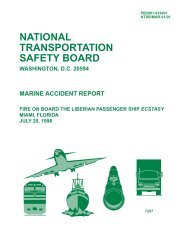Soot Deposits and Fires in Exhaust Gas Boiler - Martin's Marine ...
Soot Deposits and Fires in Exhaust Gas Boiler - Martin's Marine ...
Soot Deposits and Fires in Exhaust Gas Boiler - Martin's Marine ...
- No tags were found...
Create successful ePaper yourself
Turn your PDF publications into a flip-book with our unique Google optimized e-Paper software.
)Preheated feed water dur<strong>in</strong>g start-upIn order to avoid the condensation ofsome of the gas constituents, preheatedfeed water should always beused (temperature higher than about140°C) dur<strong>in</strong>g start-up <strong>and</strong> dur<strong>in</strong>g lowload operation, especially if the boileris not fitted with an on/off by-passduct/valve which can be activated <strong>in</strong>these runn<strong>in</strong>g conditions.c)Water circulation, correct function<strong>in</strong>gIt should be ascerta<strong>in</strong>ed that theboiler’s water circulation system <strong>and</strong>its control system are function<strong>in</strong>gproperly.d)Water circulation after eng<strong>in</strong>e stopAfter the eng<strong>in</strong>e is stopped, the boiler’swater circulat<strong>in</strong>g pump should be keptrunn<strong>in</strong>g until the boiler temperature hasfallen below 120°C, because wet oilysoot may catch fire at temperaturesas low as this.On the other h<strong>and</strong>, it is recommendednot to stop the circulat<strong>in</strong>g pump <strong>in</strong>harbour unless the boiler has beenchecked <strong>and</strong> is clean.e)Heavy smoke from eng<strong>in</strong>eIf excessive smoke is observed, eitherconstantly or dur<strong>in</strong>g acceleration, thisis an <strong>in</strong>dication of a worsen<strong>in</strong>g of thesituation. The cause should be identified<strong>and</strong> remedied. Excessive smokecould be caused by defective fuelvalves, a jiggl<strong>in</strong>g governor, <strong>in</strong>correctadjustment of the governor fuel limiter,or the malfunction<strong>in</strong>g of one (of two)auxiliary blowers, etc.The boiler should be checked <strong>and</strong>cleaned if necessary.Operat<strong>in</strong>g conditions <strong>in</strong> waterleakage situationsDnV recently <strong>in</strong>formed about a casewhere a water leakage was discoveredfrom a water tube type exhaust gas boilerRef. [6]. In order to get to port, the watercirculation was shut off. When arriv<strong>in</strong>gat anchorage, the exhaust gas boiler overheated,<strong>and</strong> the crew found that a hightemperature soot fire had occurred.The above case shows how important itis to cool the tubes, i.e. that the watercirculat<strong>in</strong>g through the tubes always functionscorrectly, <strong>in</strong> order to avoid ignition ofthe soot.In this case, the water circulation couldnot cont<strong>in</strong>ue because of the waterleakage. Therefore, <strong>in</strong> such a situationthe below actions are recommended.Actions to be taken prior to dry runn<strong>in</strong>g:a)When shutt<strong>in</strong>g off the water circulation,the ma<strong>in</strong> eng<strong>in</strong>e should also beshut down so that the exhaust gasboiler can cool down <strong>and</strong> any smoulder<strong>in</strong>gof soot deposits on the boilertubes can die out.b)The heat<strong>in</strong>g surface should be <strong>in</strong>spectedcarefully for soot deposits,<strong>and</strong> water wash<strong>in</strong>g performed, bothfor clean<strong>in</strong>g <strong>and</strong> cool<strong>in</strong>g.c)Make every effort to re-establish thewater circulation to the boiler <strong>and</strong>thereby reduce the dry runn<strong>in</strong>g periodto a m<strong>in</strong>imum.d)<strong>Boiler</strong> manufacturers allow dry runn<strong>in</strong>gof exhaust gas boilers only <strong>in</strong> thecase of emergency <strong>and</strong> with a cleanboiler. In addition they emphasize thatevery possible precaution must beobserved to prevent soot fire.Actions to be taken dur<strong>in</strong>g dry runn<strong>in</strong>g:e)Increase the frequency of soot blow<strong>in</strong>gconsiderably, <strong>and</strong> perform sootblow<strong>in</strong>g several times prior tomanoeuvr<strong>in</strong>g.f) Inspect the boiler frequently <strong>and</strong>, ifany soot is present, then water washthe boiler <strong>and</strong> <strong>in</strong>crease the soot blow<strong>in</strong>gfrequency.g)The boiler’s <strong>in</strong>struction manual mustbe read carefully <strong>and</strong> its <strong>in</strong>structionsare always to be followed.Operat<strong>in</strong>g <strong>in</strong> soot fire situationsOn the other h<strong>and</strong>, if a soot fire doesstart after all, we recommend either ofthe follow<strong>in</strong>g two types of measures,depend<strong>in</strong>g on the level of fire:Fire level 1, where an <strong>in</strong>itial soot firehas just been discovered:a) Stop the ma<strong>in</strong> eng<strong>in</strong>e, <strong>and</strong> therebythe oxygen supply to the fire.b) Cont<strong>in</strong>ue operat<strong>in</strong>g the watercirculat<strong>in</strong>g pump.c) Never use soot blowers for firefight<strong>in</strong>g, as air will feed the fire withoxygen, <strong>and</strong> steam will <strong>in</strong>volve a riskof high temperature fire.d) Stop the air circulation through theeng<strong>in</strong>e, <strong>and</strong> thereby the air supply tothe fire, i.e. keep air pressure on thediesel eng<strong>in</strong>e’s exhaust valve clos<strong>in</strong>gmechanism (closed valves).e) Water wash<strong>in</strong>g, if fitted, may beused to ext<strong>in</strong>guish the fire. This isnormally connected to the ship’s firefight<strong>in</strong>g water system.In a well-run plant any fire that startswill be small, <strong>and</strong> if the above emergencyaction is taken immediately, thefire will be damped down quickly, <strong>and</strong>water circulated by the pump will helpkeep the tubes cool <strong>and</strong> reduce anyheat damage caused by the fire, Ref. [2].If the soot fire has turned <strong>in</strong>to an ironfire, this can be <strong>in</strong>dicated by a loss ofwater, for example, if the feed waterconsumption <strong>in</strong>creases very much <strong>and</strong>/or if a low level alarm <strong>in</strong> the steamdrum is activated. A temperature sensor(normally max. 400°C) will not normallybe able to measure the high temperatures.20This document, <strong>and</strong> more, is available for download at Mart<strong>in</strong>'s Mar<strong>in</strong>e Eng<strong>in</strong>eer<strong>in</strong>g Page - www.dieselduck.net
















